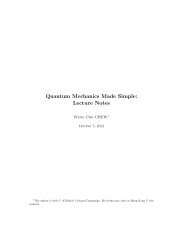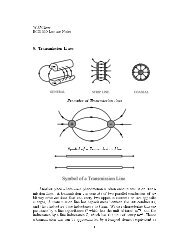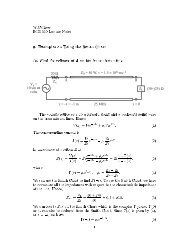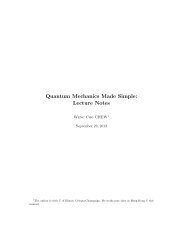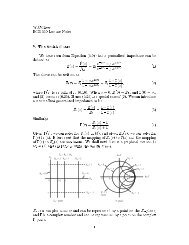r H = r H = j!E+ E = j!E r E = ;j!H p Ex(z t) = jc1j
r H = r H = j!E+ E = j!E r E = ;j!H p Ex(z t) = jc1j
r H = r H = j!E+ E = j!E r E = ;j!H p Ex(z t) = jc1j
You also want an ePaper? Increase the reach of your titles
YUMPU automatically turns print PDFs into web optimized ePapers that Google loves.
W.C.Chew<br />
ECE 350 Lecture Notes<br />
14. Skin Depth and Plane Wave in a Lossy Medium.<br />
We learn earlier that in a lossy medium, J = E, and from<br />
r H = @E<br />
@t<br />
+ J = @E<br />
@t<br />
Using phasor technique, we can convert the above to<br />
where<br />
+ E: (1)<br />
r H = j! E + E = j! E (2)<br />
is the complex permittivity. Furthermore, using that<br />
and that r H =0,r E =0,we can show that<br />
= ; j ! (3)<br />
r E = ;j! H (4)<br />
r 2 E = ;! 2 E (5)<br />
r 2 H = ;! 2 H: (6)<br />
[Refer to x 4 for details]. If we assume that E = ^xE x(z), then, we can show<br />
that<br />
d 2<br />
dz 2 E x(z) ; 2 E x(z) =0 (7)<br />
where<br />
= j! p = + j : (7a)<br />
The general solution to (7) is of the form<br />
If we assume that c 2 =0,we have only<br />
E x(z) =c 1e ; z + c 2e z : (8)<br />
E x(z) =c 1e ; z : (9)<br />
We can convert the above into a real time quantity using phasor techniques,<br />
or<br />
E x(z t) =jc 1j
where we have assumed that c 1 = jc 1j e j 1 . Hence, we see that <strong>Ex</strong>(z t) is<br />
a wave that propagates to the right with velocity v = ! and attenuation<br />
constant . We can nd from equation (7a), and<br />
r r<br />
= + j = j! ; j<br />
!<br />
= j! 1 ; j<br />
!<br />
: (11)<br />
The rst term on the RHS of (1) is the displacement current term, while the<br />
second term is the conduction current term. From (2), we see that the ratio<br />
! is the ratio of the conduction current to the displacement current in a lossy<br />
medium. is also known as the loss tangent of a lossy medium.<br />
!<br />
(i) When 1, the loss tangent is small, and the conduction current com-<br />
!<br />
pared to the displacement current is small. The medium behaves more<br />
like a dielectric medium. In this case, we can use binomial expansions to<br />
approximate (11) to obtain<br />
= j! p<br />
1 ; j 1<br />
=<br />
2 !<br />
1<br />
r<br />
p<br />
+ j! (12)<br />
2<br />
where<br />
= 1<br />
2<br />
r = ! p : (13)<br />
(ii) When 1, the loss tangent is large because there is more conduc-<br />
!<br />
tion current than displacement current in the medium. In this case, the<br />
medium is conductive. According to equation (11), when 1, we<br />
!<br />
have<br />
r<br />
= j! ;j =<br />
! p r<br />
!<br />
j! =(1+j) : (14)<br />
2<br />
Hence<br />
= =<br />
If we substitute = = 1 into (10), we have<br />
r !<br />
2 = 1 : (15)<br />
<strong>Ex</strong>(z t) =<strong>jc1j</strong> e ;z<br />
cos !t ; z + 1 : (16)<br />
2
<strong>Ex</strong>(z,t)<br />
1<br />
0.8<br />
0.6<br />
0.4<br />
2.<br />
0.2<br />
2.5<br />
0<br />
−0.2<br />
−0.4<br />
−0.6<br />
−0.8<br />
1.5<br />
t=0.<br />
1.<br />
.5<br />
<strong>Ex</strong>(z,t), t=0.,0.5,1.0,1.5,2.0,2.5<br />
omega=1, delta=0.2, phi=−0.25pi<br />
−1<br />
0 0.1 0.2 0.3 0.4 0.5<br />
z<br />
0.6 0.7 0.8 0.9 1<br />
This signal attenuates to e ;1 of its original strength at z = . Hence<br />
is also known as the penetration depth or the skin depth of a conductive<br />
medium. For other media, the penetration is 1 , but for a conductive medium,<br />
it is<br />
r<br />
2<br />
=<br />
!<br />
r<br />
1<br />
=<br />
f<br />
: (17)<br />
This skin depth decreases with increasing frequencies and increasing conductivities.<br />
(iii) When 1, it is a general lossy medium, and we have to resort to<br />
!<br />
complex arithmatics to nd and .<br />
If we square (11), we have<br />
or<br />
2 ; 2 +2j = ;! 2 ( ; j ! ) (18)<br />
2 ; 2 = ;! 2<br />
(19a)<br />
2 = ! : (19b)<br />
Squaring (19a) and adding the square of (19b) to it, we have<br />
or<br />
( 2 ; 2 ) 2 +(2 ) 2 =( 2 + 2 ) 2 = ! 4 2 2 + ! 2 2 2 (20)<br />
Combining with (19a), we deduce that<br />
2 + 2 = ! p ! 2 2 + 2 : (21)<br />
2 = 1<br />
2 (! p ! 2 2 + 2 ; ! 2<br />
3<br />
) (22a)
2 = 1<br />
Notice that when =0, =0.<br />
2 (! p ! 2 2 + 2 + ! 2<br />
4<br />
) (22b)



